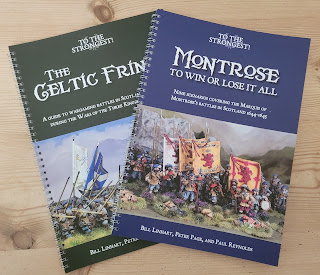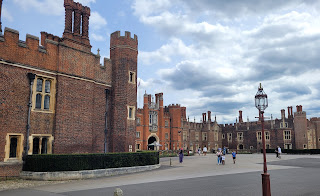Colonel Turlough MacHenry Ó Néill of the Fews' Regiment of Foot
The first of the Irish Confederate fighting men to roll off the production line here at Château KeepYourPowderDry. And there I was, thinking that fathoming out the history of the Scots gentry was complicated...
Colonel Turlough MacHenry Ó Néill was the son of Sir Turlough MacHenry Ó Néill, who was the son of Sir Turlough MacHenry Ó Néill; neither are to be confused with Sir Turlough MacHenry Ó Néill who was the father of Sir Phelim Roe Ó Néill of Kinard, who 'started' the 1641 rebellion. Or any of the other Turlough MacHenry Ó Néills...
Dissection of the name might help us understand who was who. The Ó Néills were a large extended family who effectively ruled Ulster, the different branches of the family being chieftains/lords of smaller areas within Ulster, they are usually (but not always) differentiated by having the name of their lands in their title. The Fews was rough wild land, mostly upland, the name coming from the Irish na Feá/Feadha which translates as 'woods'; this land, in South Armagh, was were 'our Henry Ó Néills' were chieftains. Turlough appears to be an honorific added to the name upon taking the role of chieftain.
With this caveat of trying to make sense of who was who, I hope I have this right...
Sir Turlough MacHenry Ó Néill inherited his title in 1640 upon the death of his father, he appears to have been in his fifties (or even sixties), having been born sometime in the 1580s or 1590s. Tomás Ó Fiaich writing in Seanchas Ardmhacha: Journal of the Armagh Diocesan Historical Society in 1974 described Sir Henry as "middle-aged, cautious, and conservative...(who) realised that it was in his own interest to remain on friendly terms with the Dublin administration". Sir Henry sided with the English, however this position was compromised by the actions of his brothers and nephews, and it became obvious that Sir Henry's estates would be seized if/when the Rebellion failed.
It is with this background that a regiment of foot in 1642 was raised in his son's name, Colonel Henry who was most likely seven years old at the time; it is believed that Sir Henry had nothing whatsoever to do with the regiment. The regiment was effectively commanded by Major Phelim Ó Néill (not to be confused with Sir Phelim Roe Ó Néill, son of Turlough McHenry Ó Néill).
By now I'm sure you understand how difficult this has all been; I wouldn't be at all surprised if at some point I end up completely rewriting the above because yet another Colonel Turlough MacHenry Ó Néill turns up. Or I've got it all completely wrong having mistaken Turlough MacHenry Ó Néill for Turlough MacHenry Ó Néill .
This may of course explain why there is a dearth of published material on the Irish Catholic Confederacy - researchers giving up after a few hours in frustration.
We don't know the strength of the regiment or how it was equipped, until the musters of 1649 and 1650 were recorded. Showing that they were equipped with pike and shot, mustering 300 and 380 men respectively. They fought at Benburb in June 1646 where the Irish army defeated the Scots with a push of pike (the Irish pike being longer than those of the Scots being a decisive factor), so it is fair to assume that they were pike and shot equipped at the battle.
Apart from that we know precious little about them: they mustered at Polmonnty in 1649; and, Clonmel in 1650 where they were besieged by the New Model Army in April and May.
The figures are mostly straight from the bag Peter Pig Irish. There is a Magister Militum monk providing some divine inspiration and moral leadership. A handful of headswaps; but most notably some fool ordered pack 47 Irish pike rather than pack 49 Irish pikemen open hand, so the very long and laborious task of cutting away cast pikes and drilling out hands has had to be undertaken. I do like these pikemen, even though I'm spending almost as long removing pikes and replacing them as I do painting the regiment.
On the subject of headswaps, Peter Pig's 'Irish heads' pack appears to owe its appearance to modern day illustrations rather than contemporary imagery, nevertheless I quite like it. We don't really know what the Irish Confederates wore upon their heads, but if we remember that Ireland was being run as a colony, and effectively being asset stripped by the English nobility, I would expect the majority of soldiers to be wearing simpler, cheaper hats rather than fashionable, expensive broad brimmed hats.
As a number of Irish soldiers had previously fought on the continent I've thrown in a few morions and cabascets, there's even a musketeer in a cabascet if you look carefully.
Colour scheme based upon Sir J T Gilbert's (History of the Irish Confederation and the War In Ireland 1641-1643) description of the Confederates fighting at Kilrush being almost indistinguishable from the bog due to the dark colours they wore.
Flags are a concern, we don't know what, if any, colours were carried by the regiment. This is pretty much true for the entire Confederate forces. A number of flags are described in a variety of sources (Blount's "The Art of Making Devises"; Hayes-McCoy's article "A Battle Flag of the Irish Confederation 1643"; Stuart Reid's numerous works; and Young's "The English Emblem Tradition Vol 3 Emblematic Flag Devices of the English Civil Wars"), all of which are helpfully collated and illustrated in Fahnen Und Standarten Vol 5. There is a school of thought that argues that all these flags should have one side green with a roundel design and the words Carolus Rex, the other side being an individual design. I went for both sides being the individual design. I've randomly assigned them to regiments. Stuart at Maverick Models creating them for me (in case you are wondering, they are listed as Marquis of Montrose Irish Foot flags 6-11).
Update: since discovering the primary source material for the Catholic Confederacy flags (see here) I've reflagged the regiment. Here's what they look like now...




















Comments
Post a Comment